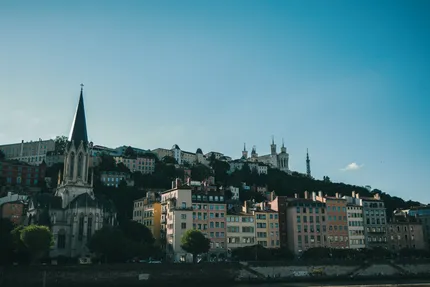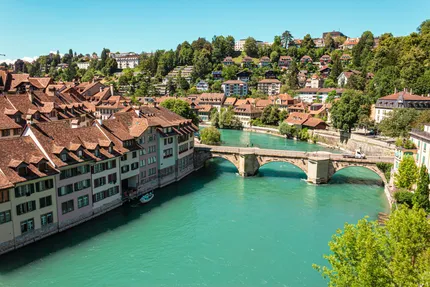CityTouring
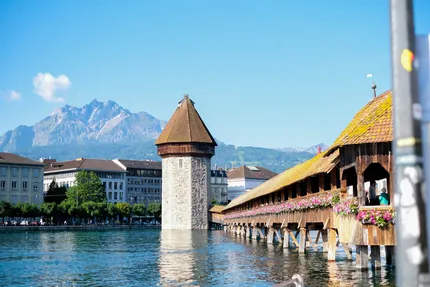
City trip to Lucerne
SwitzerlandSet on the shores of Lake Lucerne with snow-dusted peaks as a backdrop, Lucerne blends postcard views with an easily walkable historic center. The star sight is the 14th‑century Chapel Bridge (Kapellbrücke) and its octagonal Water Tower, spanning the Reuss River beside lanes of frescoed guild houses and intimate squares like Weinmarkt and Hirschenplatz. Climb the Musegg Wall’s towers in season for a panorama, then visit the solemn Lion Monument and the nearby Glacier Garden. Culture runs deep: the sleek Jean Nouvel–designed KKL hosts world-class concerts, while the Rosengart Collection shows Picasso and Klee.
Families gravitate to the Swiss Museum of Transport with its planetarium and chocolate attraction. Between museum hops, stroll the lake promenade, join a paddle steamer cruise, or plan classic mountain outings: Pilatus via cogwheel railway and gondola, or the “Queen of the Mountains,” Rigi, for mellow trails and broad views. Compact, clean, and well connected by rail and boat, Lucerne makes an effortless base for exploring central Switzerland without sacrificing the atmosphere of a small, lived‑in city.
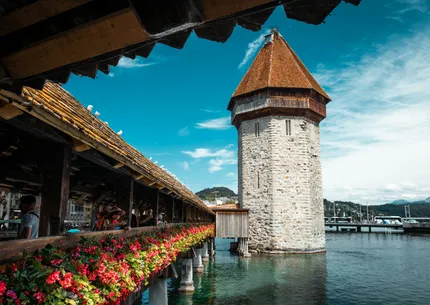
Chapel Bridge (Kapellbrücke) & Water Tower
Lucerne’s iconic 14th-century Kapellbrücke is the oldest covered wooden bridge in Europe. Its octagonal Water Tower once served as a prison and treasury. Reconstructed after the 1993 fire, the bridge displays historic painted panels. Stroll across for views along the Reuss River, flower-trimmed railings, and great photo angles of the Old Town.

Old Town (Altstadt)
Lucerne’s car-free Altstadt preserves medieval character with cobbled lanes, frescoed guildhouses, and lively squares like Weinmarkt and Hirschenplatz. Browse boutiques, cafés, and weekly markets around Rathausquai. Riverside promenades along the Reuss connect sights and bridges. It’s compact, walkable, and ideal for orienting yourself, people-watching, and discovering historic façades and hidden courtyards.
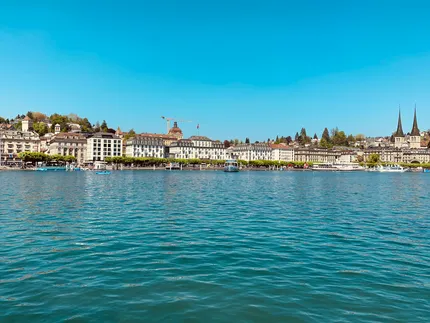
Lake Lucerne Boat Cruise
Ride historic paddle steamers or modern boats from the lakeside piers by the railway station for scenic cruises on Lake Lucerne. Fjord-like arms, steep alpine slopes, and constant views of Pilatus and Rigi make it memorable. Combine with mountain railways, hop on and off at lakeside villages, or use a day pass for flexibility.
Lucerne suits travelers who value concentrated scenery, culture, and easy logistics over big‑city buzz. Photographers and history buffs get plenty in a day: the Chapel Bridge and viewpoints from the Musegg Wall’s towers. Architecture and music lovers are well served by tours and evening performances at the KKL, plus the Rosengart Collection’s modern masters. Families find hands‑on exhibits at the Swiss Museum of Transport, its planetarium, and the Lindt Swiss Chocolate Adventure, then unwind on a short lake cruise. Casual hikers and relaxed explorers can add a half‑day to Pilatus (Golden Round Trip) or Rigi for gentle trails, broad panoramas, and easy access by cogwheel railway and gondola. Rail and boat enthusiasts will enjoy the Luzern–Interlaken Express and historic paddle steamers.
Those who enjoy inventive mountain transport can try the open‑top Cabrio cable car on Stanserhorn or the Bürgenstock funicular and cliff path, both easy half‑day outings. Shoppers looking for Swiss watches and regional crafts will find walkable options in the center. Food‑curious visitors can try Luzerner Chügelipastete and lake fish in atmospheric riverside restaurants. In winter, atmosphere‑seekers appreciate the Christmas markets around Franziskanerplatz and the boisterous Fasnacht parades. Accessibility‑minded visitors benefit from flat lakeside promenades and frequent public transport. If your priority is late‑night clubbing or a sprawling museum scene, this compact city may feel limited; for a short break focused on views, boats, and a few standout cultural stops, it is a superb fit.
Three top reasons for a city trip to Lucerne
- Explore Lucerne’s Old Town; cross Chapel Bridge and the Water Tower, admire frescoed guild houses and the Lion Monument, then climb Musegg Wall towers for views and connection to history.
- Savor Lake Lucerne scenery on paddle steamers, then ascend peaks: Mount Pilatus via the world’s steepest cogwheel railway, Mount Rigi by cogwheel and cableways, or Stanserhorn’s open-top Cabrio for panoramas.
- Immerse in culture at KKL’s concert hall and the Lucerne Festival, explore the Swiss Museum of Transport, then savor Luzerner Chügelipastete along the lakeside promenade or celebrate Fasnacht carnival traditions.
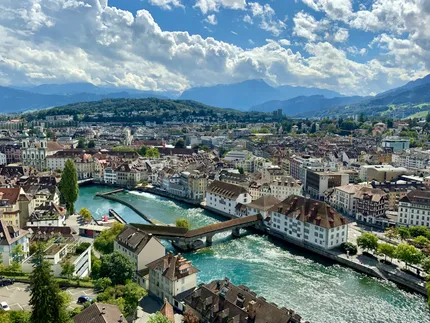
Best time to visit Lucerne
Late spring to early autumn suits most visitors. May and June bring long days, fresh greenery, and active boat and mountain schedules before peak summer crowds. July and August are warm and lively with lake cruises; the Lucerne Festival begins in August, but accommodation prices and visitor numbers rise. September often has stable weather, clear views, and a full cultural calendar. Winter (December to February) is quieter in town, festive with Christmas markets and carnival season, and ideal for snowy views on nearby Rigi or Pilatus; expect short days and cold. November can be grey and foggy. Pack layers and a rain shell year‑round.
More activities and things to see in Lucerne:
Lion Monument (Löwendenkmal)
Carved in 1820–21 by Lukas Ahorn after a design by Bertel Thorvaldsen, the Lion Monument commemorates Swiss Guards killed during the 1792 Tuileries attack. The dying lion lies above a reflecting pool in a quiet sandstone quarry. It’s a short walk from the Old Town and pairs well with Glacier Garden.
Mount Pilatus Golden Round Trip
Ascend Mount Pilatus on the Golden Round Trip: lake boat to Alpnachstad, the world’s steepest cogwheel railway to Pilatus Kulm, and cableways down to Kriens. Expect sweeping alpine views, short hikes, restaurants, and rope park options. Check weather and timetables; operations vary seasonally and queues form on clear summer days.
Mount Rigi Excursion
Ride historic cogwheel railways from Vitznau or Arth-Goldau to the “Queen of the Mountains.” Views span Lake Lucerne and central Switzerland. Enjoy panoramic walks, sunrise trips, winter sledging, and spa facilities at Rigi Kaltbad. Many passes include travel. Combine with boat travel for an easy, classic excursion from central Lucerne.
Musegg Wall and Towers
Walk along Lucerne’s preserved Musegg Wall, a 14th-century fortification with nine towers, several open seasonally. Climb the Zyt Tower to see the city’s oldest clock, which strikes one minute early. The ramparts offer views over rooftops, the lake, and surrounding mountains while illustrating the city’s medieval defenses and urban growth.
Swiss Museum of Transport (Verkehrshaus)
Switzerland’s most visited museum covers mobility by rail, road, air, and space with interactive exhibits, simulators, and historic vehicles. Highlights include extensive rolling stock, aircraft, a planetarium, and a large-format film theater. Families appreciate hands-on zones and the Lindt Chocolate Adventure. Located lakeside, it’s easily reached by boat or bus.
Rosengart Collection
An intimate museum showcasing Angela Rosengart’s collection, with an outstanding focus on Picasso and Paul Klee plus works by Impressionists and Classic Modernists. Compact galleries allow unhurried viewing of paintings, drawings, and photographs. Centrally located near the railway station, it’s a rewarding stop for art lovers seeking depth without crowds.
Glacier Garden and Mirror Maze
Discover geology and climate history at the Glacier Garden, featuring Ice Age potholes, fossil shells, and exhibits on Lucerne’s prehistoric landscape. The attraction includes the playful Mirror Maze and a panoramic observation tower. It sits beside the Lion Monument, making it easy to combine visits and understand the area’s natural heritage.
Getting around in Lucerne
Lucerne is compact and very walkable: the Old Town, Chapel Bridge, lakefront, and lion monument sit within a 10–20 minute stroll. For longer hops, the VBL bus network is dense and frequent, with real-time displays and integrated fares (Passepartout). Buy tickets in the SBB Mobile app or at station machines; inspectors check onboard. Regional mobility is excellent: Zentralbahn S-Bahn and narrow‑gauge lines link Luzern with Engelberg, Stans, Interlaken (via the Luzern–Interlaken Express), and Arth‑Goldau. Lake Lucerne boats function as public transport and are ideal for reaching Weggis, Vitznau, Beckenried, and Bürgenstock, and for classic boat‑and‑rail mountain outings. Cycling is popular, with rentals and e‑bikes widely available; lakeside routes are mostly flat, though the city has short hills and busy junctions. A car is unnecessary; the historic core is largely traffic‑calmed, parking is scarce and expensive, and public transport runs late, with night buses on weekends. Consider a Tell‑Pass or Swiss Travel Pass to cover boats, buses, and most regional trains, with discounts on mountain railways.
Getting to Lucerne
Zurich Airport (ZRH) is the nearest major gateway, about 65 km away. Direct InterRegio trains run from the airport to Lucerne about hourly, taking 60–70 minutes; via Zürich HB, connections depart every 15–30 minutes. Basel EuroAirport (BSL) is a useful alternative: shuttle to Basel SBB, then an InterRegio to Lucerne (total about 1.5–2 hours). Geneva Airport also works for long‑haul flights, with a straightforward 3‑hour rail ride. By train, Lucerne is well linked across Switzerland: Zürich HB (~45–55 min), Basel SBB (~1 hr), and Bern (~1 hr). Internationally, take high‑speed services to Basel or Zürich (TGV Lyria from Paris; ICE/IC from Frankfurt, Cologne, or Munich; Railjet from Vienna/Innsbruck) and transfer to frequent SBB trains for the final leg. From Milan, EuroCity trains through the Gotthard Base Tunnel connect to Arth‑Goldau or Zürich for an easy change to Lucerne. Long‑distance coaches operate limited routes in Switzerland; when available, services by operators like FlixBus may stop in Lucerne or Zürich, with a quick train onward.
